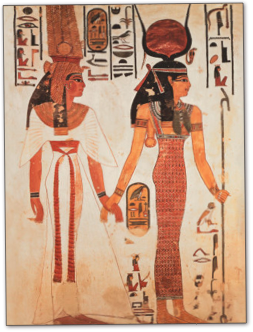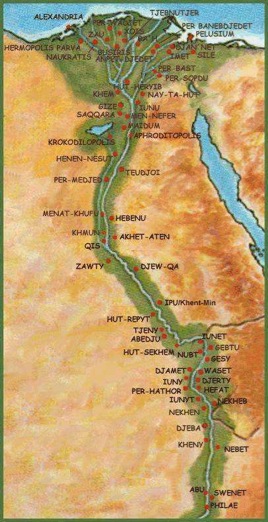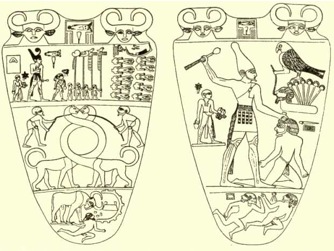


Ancient Egypt was located in the valley of the Nile River, which flows northward from East Africa into the Mediterranean Sea. Most of the valley is very narrow and surrounded on both sides by dry, mountainous desert. At the mouth of the river, the land spreads out into a wide fan-like delta.
The Nile performs the same service for Egypt that the Tigris and Euphrates does for Mesopotamia. It provides water and rich soil to a land that would otherwise be desert. Like the Tigris and Euphrates, the Nile floods regularly, but its annual flooding is regular and easier to predict and control. It rises in the summer (rather than the spring) just after the harvest, and its gentle inundation provides a new layer of silt just in time for planting season.


The Nile was such a gentle provider of necessities that Settlers on its banks were slow to take up agriculture. Wildlife flourished along its banks, so the earliest Egyptians could hunt and fish and exploit wild plants for food in order to meet their needs. By about 5000 B.C., Egyptians had domesticated sheep, cattle and goats, and had begun to raise wheat and barley to supplement the Nile’s generous natural bounty. Village communities that were fully dependent on agriculture may not have appeared until around 3500 B.C. Since the Nile was fairly easy to control, no large workforce was necessary in order to exploit it, so settlement patterns along its banks tended toward village communities rather than the cities that dominated Mesopotamian civilization. City formation was further slowed by the fact that communities did not need to support armies because the Nile valley was virtually surrounded (East & West) by nearly impassable desert. The desert not only provided protection from outsiders, but also provided metal ores and good building stone that provided the building materials for Egyptian civilization.





By about 3300 B.C., two kingdoms existed in the Nile valley– Upper and Lower Egypt – and these two kingdoms were united in 3100 B.C. when the king of Upper Egypt conquered the entire Nile valley. A stone palette from the period honors a certain Narmer, or Scorpion, as the first ruler of both Upper and Lower Egypt. On one side the palette shows Narmer wearing the crown of Upper Egypt and on the other he wears the crown of Lower Egypt.


It was easier both to create and to preserve a central government in Egypt because everyone lived on the river. Additionally, trade and government were simplified by the fact that the Nile provided one great highway for the entire kingdom. Prevailing winds made it possible to coast north with the river current and sail south in the other direction. In short, the Nile provided Route 1 (and only) for Egyptian civilization!

